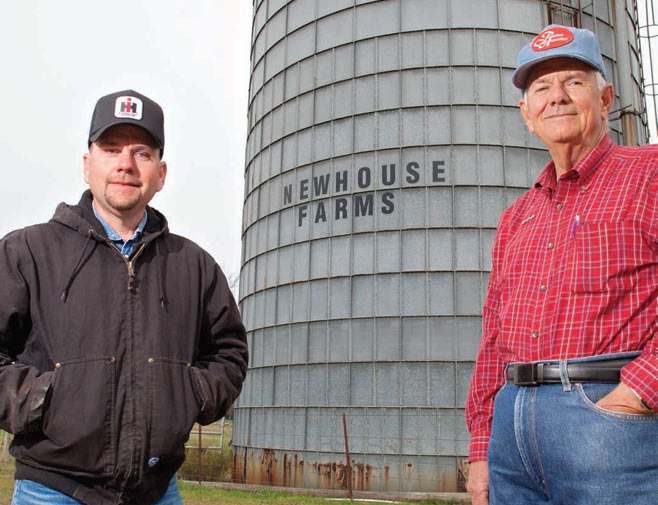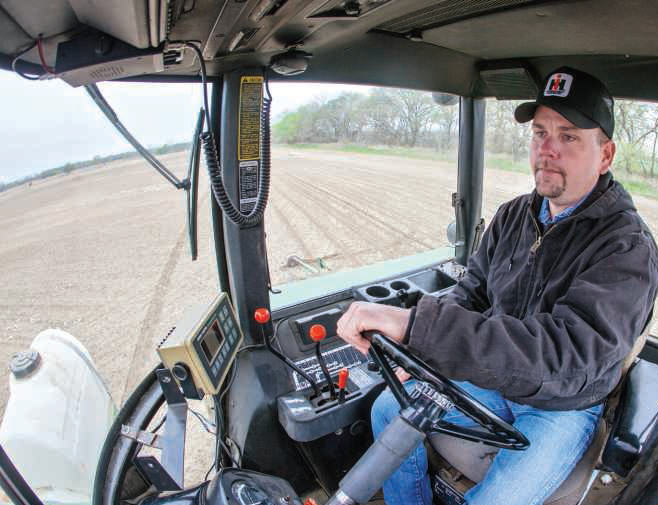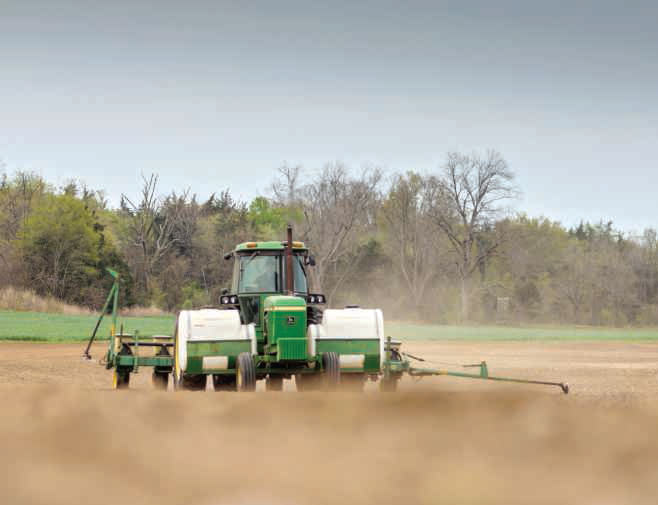
Quentin, left, and Jimmy Newhouse
Photos by Russell Graves
Quentin Newhouse eases his truck down a hill on family land overlooking the big bottomland in northeastern Fannin County, Texas. Situated just a few miles south of the Red River, the farm is green and lush with coolseason grasses, and Quentin’s cattle are well-fleshed because of it. It is March, and the field to which he is headed sits fallow for now, resting between crops and soaking up moisture left by an unusually cold and wet winter.
His dad, Mark, is already in the field working on an implement that they will soon place in service. Before long, his uncle Jimmy Newhouse arrives and the three start talking farming.
Mark and Jimmy used to operate the farm. Now 34-year-old Quentin, the fifth generation to work this land that their forefathers settled in the 1800s, is earning a living from the soil as well. In doing so, he is bucking a nationwide trend — the trend among young farm people to leave agriculture.
Aging Farmers

Quentin Newhouse prepares a field for cotton planting. Cotton is one of the few crops on the Newhouse farm that feral hogs ignore.
Nationally, more than 60 percent of farmers are over 57 years of age. In Texas, that number is closer to 59 and rising. Statistically speaking, it is rare to see someone Quentin’s age tackling the financial risks associated with farming. The 2012 United States Department of Agriculture Census showed that for every farmer under age 35, there were almost six age 65 or older.
However, Quentin — with a lifelong love for the agricultural lifestyle, a sideline construction business and the backing of a dedicated Farm Credit lender — is determined to succeed in farming like his ancestors before him.
Enterprising Spirit
The industrious Newhouse family is no stranger to hard work. Over the years, they have tried various enterprises, including a dairy that Mark and Jimmy operated in the 1970s and 1980s. After phasing out the dairy, they continued to raise cattle and farm, all while holding down other jobs.
While still in high school, Quentin started working for Jimmy’s construction company. Following graduation in 1999, he assumed a larger role in the construction firm, eventually taking over the company when Jimmy took a job with Mueller Inc., a manufacturer of metal buildings and roofing products.
In 2007, seeking a more active role in the family farm, Quentin entered into a 50-50 partnership with Jimmy, now 68, and they began full-scale farming of the family land, located seven miles north of Honey Grove.
Secondhand Equipment
Quentin soon began to acquire secondhand equipment to use in his newfound operation. Buying used equipment — some of which was not fully operational — was one way he made the transition affordable.
“With my metalworking skills, I was never afraid of buying equipment that needed some fixing,” he says, watching his 2-year-old son play with toy tractors in the dirt. “I figured if a plow was broken, I could weld on it and get it going again.”
His strategy proved sound, as startup costs in farming can be prohibitive. Nationwide, the average initial investment for a 250-acre farming operation can be upwards of $1 million.

With their mechanical and metalworking skills, the Newhouses are able to buy secondhand equipment and fix it up.
Staying Ahead of the Hogs
The pair began growing wheat and soybeans with good success, but eventually the local feral hog population developed a taste for their crops.
“Pigs got so bad that they knocked out seven acres of soybeans in one night,” says Jimmy. “So we started trying to come up with other crops they didn’t like as much.”
They tried milo, but the pigs liked it, too. They couldn’t grow corn, because that would have been like giving candy to the porcine invaders. Eventually the pair discovered that pigs didn’t bother bearded wheat, so it became one of the farm’s signature crops.
Trying Sunflowers
Along the way, Quentin and Jimmy also grew sunflowers when they could contract the crop for a favorable profit. Sunflowers perform well in Fannin County’s soils and temperate climate, and an elevator in nearby Bonham made for convenient delivery of the crop.
“We did well with sunflowers, but when the contract price fell, we couldn’t make money growing them,” Quentin explains. “So we started looking for a new crop that we could do well with and one the pigs wouldn’t eat.”
Their answer was cotton.
Going for Cotton
Historically, dryland cotton was a staple crop in Fannin County. Over the past half-century, however, more diversified crops, including cereal grains, sunflowers, corn and milo, came into favor. In fact, in 2013 the number of acres dedicated to cotton in the county was negligible. With no gins and hence no local market, the Newhouses’ cotton-farming prospects might appear dim.
The Newhouses made a go at it, however.
“That first year we grew cotton, the weather turned off dry,” Quentin says. “But we still managed to make half a bale per acre.”
Uncle and nephew persevered, and last year they had their best cotton crop yet. While they proved they can successfully grow the crop, getting it to market still remains a challenge.
“The challenge of growing cotton is that there are no gins nearby,” Jimmy admits. “We have to take the cotton over 40 miles to the gin, and then it takes several months to get the cotton sold. It’s still been worth it, though.”
An Ally in Farm Credit
For Jimmy, who once worked as a loan officer in the Farm Credit System, it’s important to have a financial partner who is familiar with the local agricultural conditions and the challenges of farming. That’s why he and Quentin rely on Texas Farm Credit for their operating, land and equipment financing, and acknowledge David Althof, senior loan officer in the cooperative’s Bonham branch, as a strong ally.
“No one else can understand what’s going on with what we do unless they understand the agriculture business,” Jimmy says. “David understands.”
In the four years he’s worked with Jimmy and Quentin, Althof says he has seen their strong work ethic and dedication to their farming operation translate into success.
“Quentin grew up involved in agriculture, working with his dad, who was a crop and dairy farmer, so he has a strong work ethic,” Althof says. Quentin has diversified into running his own small cow-calf operation, and works closely with his uncle Jimmy on their crop-farming partnership.
The Next Generation
“As a lender, it is reassuring to see experience and enthusiasm being passed down from one generation to the next,” Althof continues. “Young people like Quentin are the future of our industry.”
Still, Quentin and his wife, Heather — parents to three young children — know that starting a farming operation isn’t easy. Between the feral pigs, fickle markets and the weather, he has seen a host of challenges in the half-decade that he’s been farming.
But for the sixth generation of Newhouses who might want to work the family land someday, he knows the rewards will be worth the effort.
Construction on the Side
Even though he spends much of his time farming, Quentin still runs the construction business, and on any given day, you might find him welding the frame of a new shop or putting metal on the roof of a new home that someone else built.
“We install a lot of steel roofs,” says Quentin, explaining that metal roofs are economical, durable and considered stylish by today’s custom builders and homeowners. He also sees a new trend emerging.
“Metal houses are becoming pretty popular,” he says.
Metal houses — also known as barndominiums or barndos — are essentially built out of beams, purlins and skinned-in metal panels, much like a traditional farm shop, he explains. Inside, however, the homes incorporate traditional home construction methods, with wooden studs used to frame the walls.
“Metal homes used to be a bit cheaper to build, but now there isn’t much difference in price between a metal home and a traditionally built home,” Quentin explains. “The main savings comes in the long-term external maintenance costs. Metal is just a lot easier and cheaper to maintain.”
With his construction business doing well, Quentin finds it challenging to balance the building projects with his farming operation. For example, after an unusually cold, wet winter in northeast Texas, come spring he had to wait for concrete crews to pour slabs so he could construct the buildings. Then, once the weather had improved and the slabs were poured, it was planting time.
“If you have a full-time job, farming is the worst second job you can have,” says Quentin. “When something needs to be done on the farm, you need be at work. It’s tough fumbling that back and forth.”
But with youthful energy, an enthusiastic spirit and 17 years of experience in farming and construction, the young entrepreneur is making it all work.